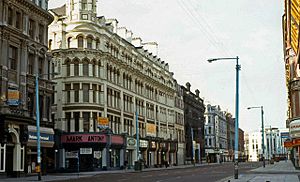Grand Central Hotel Belfast facts for kids
The Grand Central Hotel Belfast is a famous name in Belfast, Northern Ireland. It actually refers to two different hotels! The first one opened way back in 1893. It was later used by the military and then taken down. The second hotel is a newer building, which used to be an office block called Windsor House. It was changed into a hotel and opened its doors in 2018.
Contents
The First Grand Central Hotel: A Look Back
The very first Grand Central Hotel was located on Royal Avenue in Belfast. It first opened its doors in 1893. This large hotel had about 200 guest rooms. Many famous people stayed there. Even music legends like The Beatles and The Rolling Stones visited in the 1960s!
A Time of Change and Challenge
In 1972, the hotel was taken over by the British Army. They used it as a military base. From here, soldiers helped keep order in the city centre. This was during a difficult time known as The Troubles. The building was protected with special screens. These screens helped keep the troops safe from attacks. The hotel was attacked many times by different groups.
From Hotel to Shopping Centre
By the late 1980s, the army no longer needed the hotel. Developers bought the building. It was then taken down, along with a nearby building. This made space for a brand new shopping centre. The CastleCourt shopping centre was finished in 1990.
The Second Grand Central Hotel: A Modern Comeback
The second Grand Central Hotel is a much newer building. It was originally built as an office block. Its first name was Windsor House. This tall building is 23 stories high and stands 80 metres tall. You can find it on Bedford Street in Belfast.
A New Life for an Old Building
Starting in 2016, the building had a big makeover. This renovation cost about £30 million! On June 20, 2018, it opened as the new Grand Central Hotel. It's now a modern and important hotel in the city.



